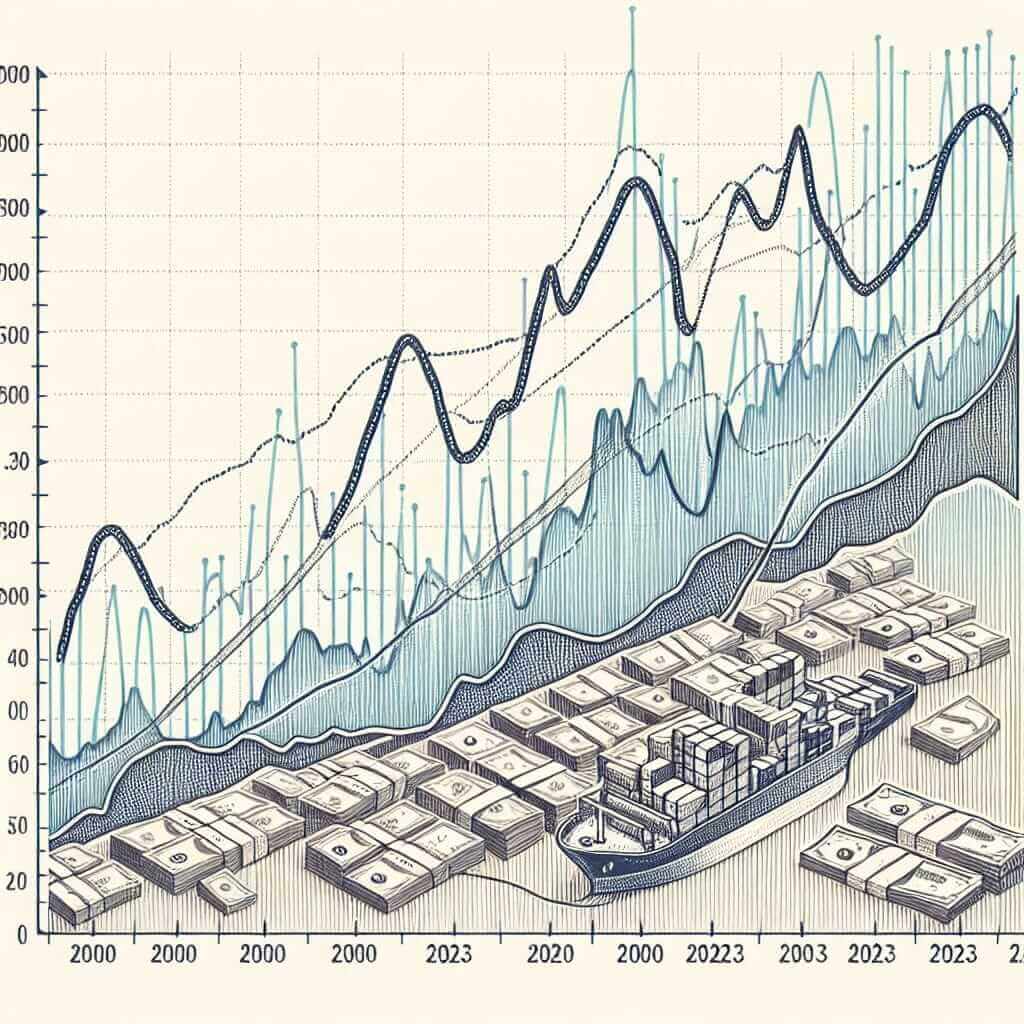Understanding global trade patterns is critical for anyone looking to excel in the IELTS Writing Task 1. The topic of exports and imports has a high frequency in the IELTS exams, often appearing as bar charts, line graphs, or tables. Today we will focus on how to navigate this topic effectively, analyzing the period from 2000 to 2023, and providing a detailed writing guide to help you aim for Band 7+.
Initial Analysis and Example Prompts
Before we dive into writing, let’s explore the specific aspects of the exports and imports topic that could appear in the exam. Typically, these tasks measure your ability to compare data, identify trends, and describe significant figures. Here are three potential prompts you might encounter:
- Line Graph Prompt: The graph below shows the value of exports and imports of Country X from 2000 to 2023. Summarize the information by selecting and reporting the main features and make comparisons where relevant.
- Bar Chart Prompt: The bar chart illustrates the amount of export and import trade in billions of dollars for Country Y over the period 2000-2023. Summarize the information by selecting and reporting the main features and make comparisons where relevant.
- Table Prompt: The table below details the export and import volumes of Country Z from 2000 to 2023. Summarize the information by selecting and reporting the main features and make comparisons where relevant.
Choosing a Prompt and Generating Data
Let’s work with the following line graph prompt:
“The graph below shows the value of exports and imports of Country X from 2000 to 2023. Summarize the information by selecting and reporting the main features and make comparisons where relevant.”
Generating Data and Creating a Line Graph
For this prompt, we can create a hypothetical line graph with the following data points (values are in billions of USD):
| Year | Exports | Imports |
|---|---|---|
| 2000 | 150 | 180 |
| 2003 | 170 | 160 |
| 2006 | 200 | 190 |
| 2009 | 220 | 210 |
| 2012 | 210 | 230 |
| 2015 | 230 | 250 |
| 2018 | 260 | 240 |
| 2021 | 280 | 270 |
| 2023 | 300 | 290 |

Analyzing the Prompt
Step-by-Step Analysis
-
Understand the Task:
- Overview: Identify the general trend.
- Details: Highlight significant figures and specific years.
-
Identify Key Trends:
- Exports: Gradually increasing from 150 billion USD in 2000 to 300 billion USD in 2023.
- Imports: Fluctuating but showing an overall upward trend from 180 billion USD in 2000 to 290 billion USD in 2023.
-
Make Comparisons:
- Compare the trends in exports and imports.
- Highlight years where the trends intersect or diverge significantly.
Sample Answer
Writing Task 1: Band 7+ Sample
The line graph provides an overview of the value of exports and imports for Country X between 2000 and 2023. Overall, both exports and imports experienced an upward trend despite some fluctuations over the period.
Initially, in 2000, the value of exports was 150 billion USD, which increased steadily to reach 300 billion USD by 2023. Notably, there were certain periods where the growth rate was more pronounced. For example, from 2015 to 2021, exports rose sharply from 230 billion USD to 280 billion USD.
In comparison, the import values started at a higher point of 180 billion USD in 2000, showing a fluctuating but generally increasing trend. Imports decreased slightly from 2000 to 2003, dropping from 180 billion USD to 160 billion USD, then resumed a positive trend. By 2023, imports had climbed to 290 billion USD.
Significant points of interest include the period between 2012 and 2015, where imports surged from 230 billion USD to 250 billion USD, contrasting with the stable growth of exports during the same period. Another key observation is that the values for both imports and exports remained close, especially notable in 2015 and 2021, indicating balanced trade practices.
In summary, while both exports and imports for Country X have shown an upward trajectory from 2000 to 2023, exports have generally grown more consistently compared to the more variable nature of imports.
Word count: 234
Key Vocabulary and Grammar Tips
Vocabulary
-
Fluctuate (verb) /ˈflʌk.tʃu.eɪt/:
- Meaning: To change, especially continuously and between one level or thing and another.
- Example: “The import values fluctuated significantly over the years.”
-
Pronounced (adjective) /prəˈnaʊnst/:
- Meaning: Very noticeable or marked.
- Example: “The growth rate was more pronounced between 2015 and 2021.”
-
Surge (verb) /sɜːrdʒ/:
- Meaning: To increase suddenly and strongly.
- Example: “Imports surged from 230 billion USD to 250 billion USD during the period.”
-
Trajectory (noun) /trəˈdʒek.tər.i/:
- Meaning: The path followed by an object moving under the action of given forces.
- Example: “Both exports and imports have shown an upward trajectory.”
-
Intersects (verb) /ˌɪn.təˈsekt/:
- Meaning: To cross or meet at one or more points.
- Example: “Several key points are where exports and imports intersect.”
Grammar Tips
-
Comparative Constructions:
- Use terms like ‘more than’, ‘less than’, ‘greater than’ to make clear comparisons.
- Example: “Exports rose more steadily than imports from 2000 to 2023.”
-
Passive Voice for Trends:
- To add variety to sentence structures, employ passive constructions.
- Example: “An increase was observed in the exports from 2015 to 2021.”
-
Present Perfect Tense for Overviews:
- When describing trends from past to present, use the present perfect tense.
- Example: “Both exports and imports have experienced an upward trend.”
Conclusion
In conclusion, understanding how to analyze and describe trends in the exports and imports of a country is crucial for achieving a high score in IELTS Writing Task 1. Practice by comparing data, identifying key trends, and utilizing relevant vocabulary and grammar effectively. With this method, you will be better equipped to tackle similar tasks and aim for a Band 7+ score.